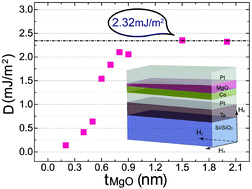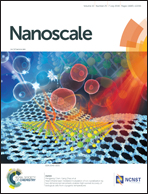Tuning the Dzyaloshinskii–Moriya interaction in Pt/Co/MgO heterostructures through the MgO thickness†
Abstract
The interfacial Dzyaloshinskii–Moriya interaction (DMI) in ferromagnetic/heavy metal ultra-thin film structures has attracted a lot of attention thanks to its capability to stabilize Néel-type domain walls (DWs) and magnetic skyrmions for the realization of non-volatile memory and logic devices. In this study, we demonstrate that magnetic properties in perpendicularly magnetized Ta/Pt/Co/MgO/Pt heterostructures, such as magnetization and DMI, can be significantly influenced by the MgO thickness. To avoid the excessive oxidation of Co, an ultrathin Mg layer is inserted to improve the quality of the Co–MgO interface. By using field-driven domain wall expansion in the creep regime, we find that non-monotonic tendencies of the DMI field appear when changing the thickness of MgO. With the insertion of a monatomic Mg layer, the strength of the DMI could reach a high level and saturate. We conjecture that the efficient control of the DMI is a result of subtle changes of both Pt/Co and Co/MgO interfaces, which provides a method to optimize the design of ultra-thin structures achieving skyrmion electronics.



 Please wait while we load your content...
Please wait while we load your content...